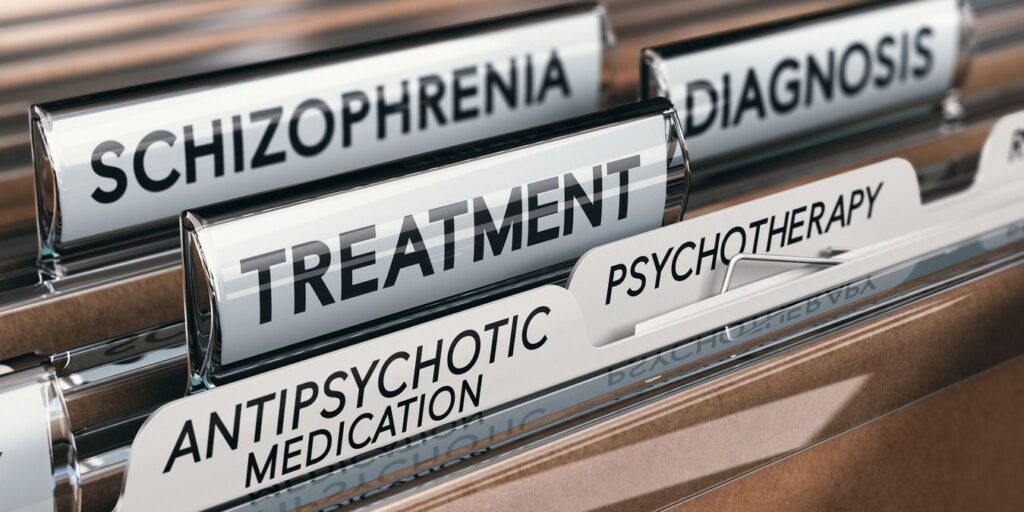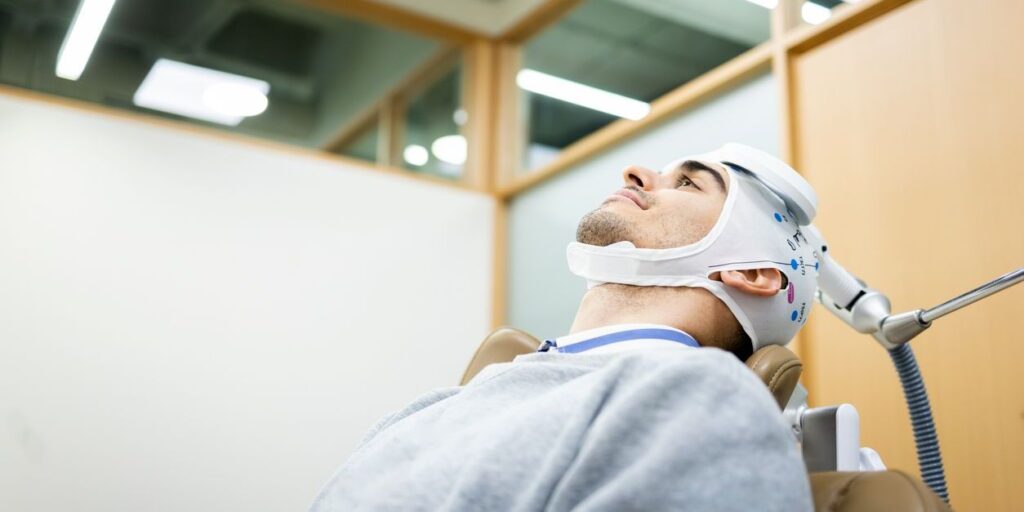At Crownview Psychiatric Institute, we have extensive experience working with people with a history of trauma, people who have experienced a traumatic event or events, and people who meet the clinical diagnostic threshold for severe and/or complex PTSD. Our treatment team uses talk therapy, educational programs, and a whole-person approach to recovery, designed to provide our clients with the skills they need to return to their daily activities and lead a full and productive life.
In some cases, when indicated by a comprehensive psychiatric assessment, medication is an important part of the treatment plan for people with a history of trauma or people diagnosed with severe and/or complex PTSD.
One medication-based approach we use is called the stellate ganglion block (SGB). The procedure we use to administer the SGB is called the Dual Sympathetic Reset (DSR SGB).
What is a Stellate Ganglion Block (SBG)?
The stellate ganglion block is a process that involves the injection of a local anesthetic into the stellate ganglion, which is a cluster of nerves located in the neck on both sides of the voice box. The injection eases pain in the upper neck, head, upper chest, and upper arms. In fact, scientists initially developed SGB for this purpose: pain relief.
The SGB has now been in use for decades as an FDA-approved treatment for pain relief for decades. However, in recent years, researchers realized that blocking the action of the nerves in the stellate ganglion – part of the sympathetic nervous system – might be beneficial for people with PTSD.
The goal of the SGB for PTSD is to provide relief from symptoms such as sleep disturbance, anxiety, irritability, difficulty concentrating, jumpiness, severe headaches, and other life-altering, disruptive symptoms related to anxiety disorders.
These symptoms are very common in people diagnosed with all types of PTSD. The SGB works by regulating the sympathetic nervous system – which works overtime in people with PTSD – and can reset the fight-or-flight response to a healthy baseline.
Now, a new version of the SGB is available to our patients:
Dual Sympathetic Reset (DSR) SGB Treatment for Mental Health
What is the Dual Sympathetic Reset (DSR SGB)?
The DSR SGB is the latest approach in delivering the SGB to patients with PTSD.
Following years of research into the most effective way to administer the SGB for PTSD, scientists have developed a new protocol for SGB, called the Dual Sympathetic Reset (DSR). This method can yield the most effective results for the SGB.
Research shows the following difference:
Traditional SGB treatment relieves symptoms in around 70-75% of patients.
The new DSR SGB protocol shows a success rate of over 80%
How does the new method work?
Dual Sympathetic Reset (DSR SGB) Treatment for Mental Health: The Procedure
Only licensed physicians are qualified to administer the SGB Dual Sympathetic Reset.
With the support of our experienced nursing team, one of our trained, skilled physicians uses image-guided techniques to inject a local anesthetic into the stellate ganglion, located in the neck. This cluster of nerves, when stimulated, prepares a human for stress by increasing heart rate, increasing blood flow to the muscles, and decreasing blood flow to the surface of the skin.
When interrupted by a local anesthetic, these phenomena cannot contribute to PTSD symptoms associated with the SGB. After the DSR SGB block injection, many patients report relief from the symptoms of anxiety and PTSD.
The DSR protocol requires two injections to enhance its effectiveness in treating PTSD and anxiety symptoms. Clinicians administer the DSR SGB injections on the right side of the neck, and patients who don’t have an adequate response from the initial procedure may receive a second set of injections on the left side of the neck.
This includes a restored sense of safety that allows patients to fully commit to and participate in the other types of therapy common for the treatment of PTSD, including trauma-focused cognitive behavioral therapy (TF-CBT), dialectical behavior therapy (DBT), eye movement desensitization and reprocessing (EMDR), prolonged exposure therapy (PE), and others.
Dual Sympathetic Reset (DSR SGB) and PTSD
PTSD is a life-altering disorder that can be debilitating.
The SGB is part of the sympathetic nervous system, which, as we discuss above, is known to contribute to the symptoms of PTSD. Mental health professionals understand that extreme trauma can have a negative impact on this system. One way to think about an extreme trauma – and its persistent side effects – is that it can cause the part of the sympathetic nervous system involved in our fight or flight response to become permanently activated.
In other words, the fight or flight response gets stuck in the always on position.
That’s why PTSD symptoms may persist for years: the sympathetic nervous system does the right job, but at the wrong time, and for far too long. A reset with the DSR SGB can change that, and restore the stellate ganglion to a safe and heathy baseline.
PTSD: Important Facts
PTSD can develop in individuals who have lived through a shocking, dangerous, or traumatic event. A violent, unpredictable event often leads to PTSD, such as a physical assault or a car accident. But an overt, sudden, violent event is not the only thing that can lead to PTSD. Unexpected life events, such as the sudden death of a loved one, can also lead to PTSD. Symptoms typically begin within three months of the traumatic incident, and may last for years.
To learn more about PTSD, please click here:
Treatment for PTSD at Crownview Psychiatric Institute
Symptoms of PTSD are often disruptive and cause significant medical, interpersonal, and social impairment. There are various treatments available for PTSD, including psychotherapy and medication, but they don’t work for everyone.
The DSR SGB can be effective for patients who don’t respond fully to conventional therapies.
The National Institute of Mental Health (NIMH) indicates that anyone can develop PTSD at any age. To meet the diagnostic criteria for PTSD as defined by the Diagnostic and Statistical Manual of Mental Disorders, Volume 5 (DSM-5), an adult must show the following for at least one month:
- At least one re-experiencing symptom, such as a flashback, bad dreams, or frightening thoughts
- One avoidance symptom, such as avoiding thoughts or feelings related to the traumatic event or avoiding objects, events, or places associated with the event
- At least two arousal and reactivity symptoms, such as being easily startled, feeling tense and on edge, having difficulty sleeping, and experiencing angry outbursts
- At least two cognition and mood symptoms, such as trouble remembering the traumatic event, negative thoughts about oneself or the world, distorted feelings like guilt or blame, or a loss of interest in enjoyable activities
First-line treatments for PTSD include psychotherapy, medication, or a combination of the two.
However, for some people, these approaches simply do not work. In the beginning of the treatment process, some patients cannot engage in talk therapy without experiencing negative consequences, such as re-traumatization, which is exactly what they want to avoid. DSR SGB provides an alternate, innovative approach to improving the health and well-being of people with PTSD.
Some of the potential benefits of DSR SGB for PTSD include:
Destigmatizing treatment:
- Many people are reluctant to rely on psychotherapy or medication to treat their symptoms.
- For some, the knowledge that they are undergoing a physical procedure to treat their mental illness can validate the severity of their PTSD without robbing them of their agency.
A fast-acting treatment alternative:
- Some patients report improvements within minutes of the procedure, and some within days.
- Many patients with PTSD do not want to wait for psychotherapy or typical medication to work. They want relief from disruptive symptoms as soon as possible.
Simple administration:
- The DSR SGB may reduce symptoms of PTSD for days to weeks, reducing the need for daily medication or daily psychotherapy
- For some patients, this option works best: they prefer a course of treatment that doesn’t require a high level of maintenance
Is a Stellate Ganglion Block Right for You?
The only way to answer this question is through consultation with your medical team after a comprehensive psychiatric and biopsychosocial assessment administered by a licensed, qualified, experienced mental health professional.
An accurate diagnosis is the first step. Collaboration with a skilled treatment team is the second step, which can lead to a treatment plan that may or may not include DSR SGB.
In some cases, psychotherapy, medication, and an intentional focus on symptom management, emotional regulation, and life skills lead to a full recovery from PTSD. In cases where patients require additional help, we find DSR SGB treatment an effective approach for people with severe, complex PTSD symptoms.
Learn More Today
If you or someone in your family has been struggling with acute symptoms of posttraumatic stress disorder, the stellate ganglion block may be an appropriate treatment that can bring relief from severe PTSD symptoms quickly.




 Gianna Melendez
Gianna Melendez Jodie Dahl, CpHT
Jodie Dahl, CpHT